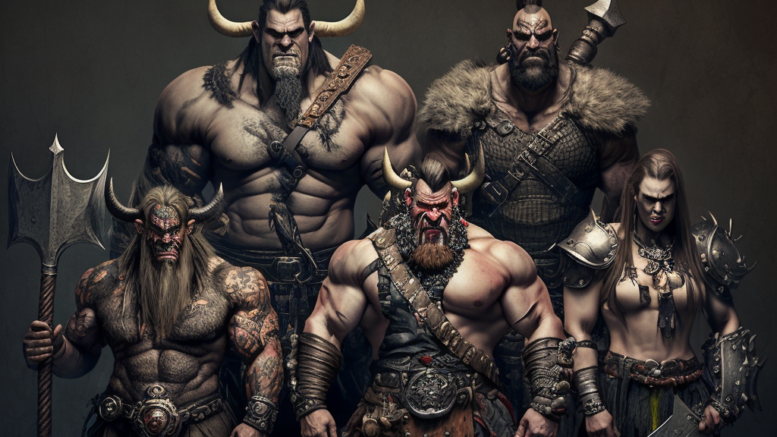The barbarian class in both Dungeons and Dragons 5th edition (D&D 5e) and Pathfinder 2nd edition (PF2e) offers a unique playstyle, with its own set of pros and cons.
In D&D 5e, the barbarian class is known for its high hit points, rage ability, and damage resistance. The rage ability allows a barbarian to enter a state of fury, granting them additional damage and temporary hit points. The damage resistance feature also makes them difficult to take down in battle. Additionally, the barbarian class has the ability to gain extra attacks as they level up, increasing their damage output even further. They also have access to a variety of rage powers that can grant them different bonuses and abilities, such as increased movement speed, increased accuracy, and the ability to shrug off certain types of damage.
One of the biggest pros of playing a barbarian in D&D 5e is their high damage output. They have the ability to deal a significant amount of damage to enemies, making them a valuable asset in combat. Additionally, the class is relatively easy to play, with simple mechanics and a straightforward playstyle. This makes the class well-suited for players who are new to the game or who want to play a character that is easy to understand and play.
However, there are also cons to playing a barbarian in D&D 5e. One of the biggest downsides is their lack of versatility. The class is focused mainly on dealing damage, and does not have many options for players who want to play a more supportive role or have a character with a wide range of abilities. Additionally, the class lacks in-depth mechanics and may become repetitive for some players. The barbarian class also struggles with low armor class, making them more vulnerable to enemy attacks.
In PF2e, the barbarian class is also known for its high hit points and damage output, but it has more nuanced mechanics. For example, the barbarian class has a unique feature called ‘Frenzy’ that allows them to make additional attacks at the cost of accuracy. This allows players to choose between making more attacks and increasing their chances of hitting, or making fewer attacks but with a higher chance of hitting. Additionally, the PF2e barbarian has access to a variety of ‘Rage Powers’ that provide different bonuses and abilities, such as increased critical hit chances, the ability to ignore difficult terrain, and the ability to knock enemies prone.
One of the biggest pros of playing a barbarian in PF2e is its complexity. The class has a wide range of abilities and options that allow players to create a unique character. Additionally, the class is well-suited for players who want to play a more aggressive, front-line character. The class also has a good balance of offense and defense abilities, making them more versatile in combat.
However, there are also cons to playing a barbarian in PF2e. One of the biggest downsides is that the class can be difficult to play, especially for new players. The class has a lot of mechanics to keep track of, and it may take some time to master the class’s abilities. Additionally, the class can be less effective in certain situations, such as in non-combat scenarios. The class also has a high level of dependency on their rage abilities, making them less effective when they are unable to rage.
In summary, both D&D 5e and PF2e offer unique takes on the barbarian class. D&D 5e’s barbarian class is simple to play and excels at dealing damage, but lacks versatility. On the other hand, PF2e’s barbarian class is more complex and offers a wider range of options, but can be difficult to play for new players. Both classes have their own strengths and weaknesses and players must weigh these factors when deciding which game and class to play.
In terms of nuance, D&D 5e’s barbarian class is more straightforward, with a focus on increasing damage output and survival in combat. The class’s rage ability and damage resistance feature make them a formidable force in battle, but they lack versatility and may become repetitive for some players. In contrast, PF2e’s barbarian class offers more complexity and options. The class’s Frenzy feature and wide range of Rage Powers allow players to create a unique character with a good balance of offense and defense abilities. However, the class can be difficult to play, and players must master the class’s mechanics to fully utilize its capabilities.
In terms of examples, a D&D 5e barbarian might be a fierce warrior who charges into battle and deals massive amounts of damage to enemies. They might have a simple and straightforward playstyle, focusing on increasing their damage output and survival in combat. On the other hand, a PF2e barbarian might be a skilled warrior who uses their Frenzy ability to make additional attacks at the cost of accuracy. They might also have a variety of Rage Powers, such as increased critical hit chances, the ability to ignore difficult terrain, and the ability to knock enemies prone. This character would have a more nuanced playstyle and be able to adapt to different combat situations.
Ultimately, the choice between playing a barbarian in D&D 5e or PF2e will depend on personal preference and the type of gameplay that the player prefers. Both classes offer unique features and abilities, and players must weigh the pros and cons of each class to decide which one is the best fit for them.
So what are your thoughts on the barbarian class? Please share in the comment section, I promise not to RAGE too much 😉

Be the first to comment on "Rage Against the Machine: A Comparison of Barbarian Classes in D&D 5e and PF2e"